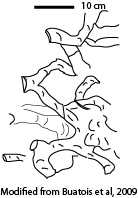Sinusichnus Gilbert 1996
DESCRIPTION: A burrow system consisting of horizontal sinusoidal tunnels showing very frequent branching and very few short shafts. In most of cases, the tunnels are regular sine curves with amplitude between 6 and 35 mm and wavelength between 35 and 185 mm. Sometimes they are less regular and rarely almost straight. Cross-sections of the tunnels are usually ovoid with widths varying between 2 and 25 mm in different specimens but remaining very constant in each particular burrow system. Vertical shafts are very rare and short, and they are located on top of the branching points. The most common branching points constitute three tunnels converging at 120 degrees angles and forming a three- armed helix-like configuration. Sometimes the branching points form a T-like junction, and occasionally four tunnels converge in a branching point. Retrusive spreite have been observed in a few specimens. Small and large sized have been observed together, leading to the assumption that these are both juveniles and adults.
BEHAVIOR(S): fodinichnia and agrichnia
ENVIRONMENTAL SETTINGS: Shallow marine, restricted basins, fully marine
POSSIBLE TRACEMAKERS: Deposit-feeding Crustaceans, similar to Thalassinoides
GEOLOGIC RANGE: Cretaceous-Pliocene
ADDITIONAL REFERENCES: de Gibert, Jeong, Martinell, Lethaia 1999
REMARKS: Preserved as sand-filled, more rarely clay-filled, or shell-filled full reliefs in clays, or as epireliefs and hyporeliefs in sandstone beds. Sinuschnichus can appear similar to Cochlichnus, made by worms, however, Cochlichnus and Sinusichnus traces result from very different behavior and constructional patterns. While Cochlichnus is a backfilled non- reusable trace (repichnia), Sinusichnus is an open network constructed for feeding purposes. Hence, Sinusichnus-making animals do not need as much frictional resistance in progression as Cochlichnus-making animals do.
